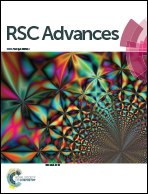Structure formation process, heat-insulation property and cyclic compression–resilience performance of mullite fibres/whiskers frameworks†
Abstract
Mullite fibres/whiskers frameworks (MF/MW frameworks) were prepared by mixed-slurry-filtration and heat-treating. Hierarchical fibres/whiskers structure formed in the frameworks through fluorine-catalyzed gas-phase reaction. Topaz rods as a transient product first formed in the frameworks, and then gradually transformed into mullite whiskers. Intersected mullite whiskers served as lap-jointing points of the fibres. The volume density, apparent porosity and thermal conductivity of the samples heat-treated at 1100–1500 °C were 0.402–0.541 g cm−3, 81.2–85% and 0.1191–0.1647 W m−1 k−1, respectively. Cyclic compression–resilience performance (maximum stress = 0.4 MPa) of the samples was tested at room temperature. The compression ratio, permanent deformation ratio and resilience ratio of the samples in the first circle compression–resilience test were 2.031–3.833%, 0.125–0.042% and 93.85–98.28%, respectively. The excellent thermal/mechanical properties indicated that the MF/MW frameworks were suitable for being applied as high temperature heat-insulation/sealing materials.


 Please wait while we load your content...
Please wait while we load your content...